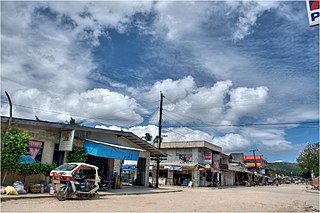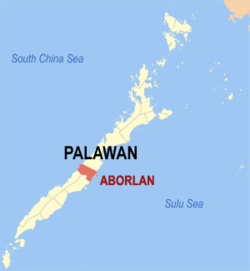
Coron, officially the Municipality of Coron, is a 1st class municipality in the province of Palawan, Philippines. According to the 2020 census, it has a population of 65,855 people.

Brooke's Point, officially the Municipality of Brooke's Point, is a 1st class municipality in the province of Palawan, Philippines. According to the 2020 census, it has a population of 73,994 people.

Bataraza, officially the Municipality of Bataraza, is a 1st class municipality in the province of Palawan, Philippines. According to the 2020 census, it has a population of 85,439 people.

Santa Cruz, officially the Municipality of Santa Cruz, is a 1st class municipality in the province of Marinduque, Philippines. According to the 2020 census, it has a population of 54,692 people.

Looc, officially the Municipality of Looc, is a 5th class municipality in the province of Occidental Mindoro, Philippines. According to the 2020 census, it has a population of 7,802 people.

Rizal, officially the Municipality of Rizal, is a 3rd class municipality in the province of Occidental Mindoro, Philippines. According to the 2020 census, it has a population of 40,429 people.

Santa Cruz, officially the Municipality of Santa Cruz, is a 1st class municipality in the province of Occidental Mindoro, Philippines. According to the 2020 census, it has a population of 42,417 people.

Pola, officially the Municipality of Pola, is a 3rd class municipality in the province of Oriental Mindoro, Philippines. According to the 2020 census, it has a population of 35,455 people. It is 74 kilometres (46 mi) from Calapan.

Agutaya, officially the Municipality of Agutaya, is a 5th class municipality in the province of Palawan, Philippines. According to the 2020 census, it has a population of 12,867 people.

Araceli, officially the Municipality of Araceli, is a 4th class municipality in the province of Palawan, Philippines. According to the 2020 census, it has a population of 14,434 people.

Balabac, officially the Municipality of Balabac, is a 2nd class municipality in the province of Palawan, Philippines. According to the 2020 census, it has a population of 42,527 people.

Dumaran, officially the Municipality of Dumaran, is a 3rd class municipality in the province of Palawan, Philippines. According to the 2020 census, it has a population of 23,528 people.

Magsaysay, officially the Municipality of Magsaysay, is a 5th class municipality in the province of Palawan, Philippines. According to the 2020 census, it has a population of 12,603 people.

Narra, officially the Municipality of Narra, is a 1st class municipality in the province of Palawan, Philippines. According to the 2020 census, it has a population of 77,948 people.

Linapacan, officially the Municipality of Linapacan, is a 5th class municipality in the province of Palawan, Philippines. According to the 2020 census, it has a population of 16,424 people.

Quezon, named by the late President Manuel L. Quezon and officially named the Municipality of Quezon, is a first-class municipality in the province of Palawan, Philippines. According to the 2020 census, it has a population of 65,283 people.

Rizal, officially the Municipality of Jose P. Rizal,, is a 1st class municipality in the province of Palawan, Philippines. According to the 2020 census, it has a population of 56,162 people.

Roxas, officially the Municipality of Roxas, is a 1st class municipality in the province of Palawan, Philippines. According to the 2020 census, it has a population of 69,624 people.

Taytay, officially the Municipality of Taytay, is a 1st class municipality in the province of Palawan, Philippines. According to the 2020 census, it has a population of 83,357 people.

Bansud, officially the Municipality of Bansud, is a 2nd class municipality in the province of Oriental Mindoro, Philippines. According to the 2020 census, it has a population of 42,671 people.
























